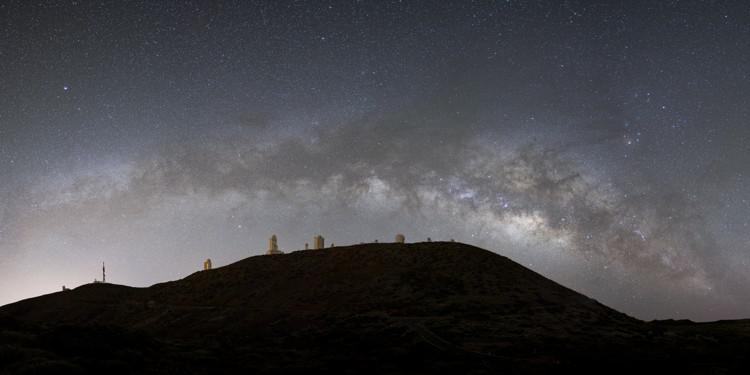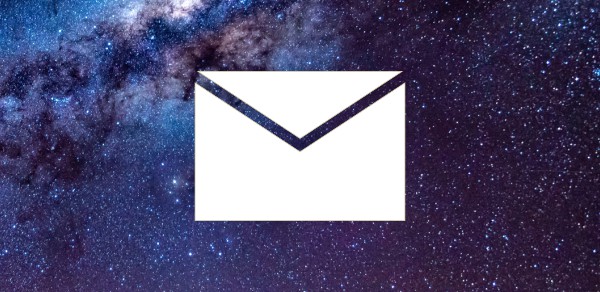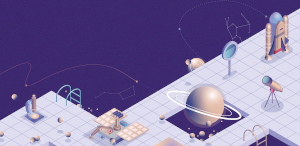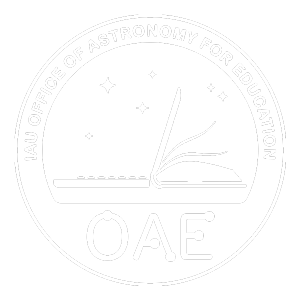This page describes an image Teide Observatory
Image caption:
Honourable mention in the 2022 IAU OAE Astrophotography Contest, category Still images of celestial patterns.
Taken in May 2022 in Teide National Park in Tenerife, Spain, this image shows the arc of the Milky Way galaxy crossing the sky, accompanied by prominent constellations over the professional telescopes located on the mountains of that island. While the telescopes and the people working with them may ignore the constellations, the photographer managed to catch the Milky Way in such a way that it almost matches the shape of the mountain.
The bright star in the top-left side of the image is Vega, one of the brightest stars in the night sky and located in the small constellation Lyra. Being a white star, it is the standard star astrophysicists use to define the colour scale. As it is also a relatively close star, only about 25 light-years away, with a relatively simple name, it frequently appears in modern science fiction, for example in Carl Sagan’s famous novel “Contact”, which was filmed in 1997 with Jodie Foster starring as a radio astronomer.
The bright star seen below the galaxy and on the left half of the image is Altair, also one of the brightest stars in the night sky and located in the constellation Aquila. Together with Deneb — a star in the constellation Cygnus (the Swan) that is not visible in this image — Altair and Vega form the Summer Triangle, a characteristic asterism of popular astronomy in the northern hemisphere, where these telescopes are located.
On the right side of the image we can see the constellation Scorpius. This is easily identified by its brightest star, Antares, the reddish star in the Scorpion’s heart. Below it, the whole body and tail of the Scorpion can be found and above it the celestial Scorpion's head is represented by three bright bluish stars. Below the tail and above the horizon, the constellation of Ara, the Altar, is half-visible, but like all the stars of Sagittarius in the Milky Way and the much fainter ones in Hercules and Ophiuchus above it, these constellations are more difficult to pinpoint in this photograph full of stars. The head of Ophiuchus is the relatively bright star in the middle between Vega and Antares. In addition to the huge size of this constellation, it is also important because it is the thirteenth one of the Zodiac, and the Sun spends roughly three weeks in Ophiuchus, after only five days in Scorpius. Furthermore, Ophiuchus represents the model for the mythological best doctor in the world, called Asklepios in Greek mythology, and Aesculab in Latin. His constellation praises all people working in medical professions, including nurses, pharmacists and doctors.
Scroll to captions in other languages
Image credit:
Curd-Christian Tengeler/IAU OAE
DOI: 10.5281/zenodo.7425530
Related glossary terms:
Astronomical Observatory
, Astronomy
, Dust
, Dust Cloud
, Interstellar Extinction
, Milky Way
, Scorpius
Categories:
Milky Way and Interstellar Medium
, Naked Eye Astronomy
, Telescopes, Instruments and Observatories
Image license: Creative Commons Attribution 4.0 International (CC BY 4.0) Creative Commons Attribution 4.0 International (CC BY 4.0) icons
The media file captions presented on the OAE website were written, translated and reviewed by a collective effort from the OAE, the OAE Centers and Nodes, the OAE National Astronomy Education Coordinators (NAECs) and other volunteers. You can find a full list of credits for our translation project here. All media file captions are released under a Creative Commons CC BY-4.0 license and should be credited to "IAU OAE". The media files themselves may have different licenses (see above) and should be credited as listed above under "credit".
If you notice a factual error in this caption or an error in any of its translations then please get in touch.
Captions in Different Languages:
Image caption: ২০২২ IAU OAE অ্যাস্ট্রোফটোগ্রাফি প্রতিযোগিতায় সম্মানজনক উল্লেখ, স্বর্গীয় নিদর্শনের স্থির চিত্র।
২০২২ সালের মে মাসে স্পেনের টেনেরিফের টেইডে ন্যাশনাল পার্কে তোলা, এই চিত্রটি সেই দ্বীপের পাহাড়ে অবস্থিত পেশাদার টেলিস্কোপের উপর বিশিষ্ট নক্ষত্রপুঞ্জের সাথে আকাশ পেরিয়ে আকাশগঙ্গা ছায়াপথের চাপ দেখায়। যদিও টেলিস্কোপ এবং তাদের সাথে কাজ করা লোকেরা নক্ষত্রপুঞ্জকে উপেক্ষা করতে পারে, ফটোগ্রাফার এমনভাবে মিল্কিওয়ে ধরতে সক্ষম হন যে এটি প্রায় পাহাড়ের আকারের সাথে মিলে যায়।
ছবিটির উপরের-বাম দিকের উজ্জ্বল নক্ষত্রটি হল ভেগা, রাতের আকাশের সবচেয়ে উজ্জ্বল নক্ষত্রগুলির মধ্যে একটি এবং ছোট তারামণ্ডল লিরাতে অবস্থিত৷ একটি সাদা নক্ষত্র হওয়ায়, এটি হল স্ট্যান্ডার্ড তারকা জ্যোতির্পদার্থবিদরা রঙের স্কেল নির্ধারণ করতে ব্যবহার করেন। যেহেতু এটি একটি অপেক্ষাকৃত কাছাকাছি নক্ষত্র, মাত্র ২৫ আলোকবর্ষ দূরে, একটি অপেক্ষাকৃত সহজ নাম সহ, এটি প্রায়শই আধুনিক বিজ্ঞান কল্পকাহিনীতে দেখা যায়, উদাহরণস্বরূপ কার্ল সেগানের বিখ্যাত উপন্যাস "যোগাযোগ" এ, যা ১৯৭৭ সালে জোডি ফস্টারের সাথে চিত্রায়িত হয়েছিল একজন রেডিও জ্যোতির্বিজ্ঞানী হিসেবে অভিনয় করছেন।
ছায়াপথের নীচে এবং চিত্রের বাম অর্ধে দেখা উজ্জ্বল নক্ষত্রটি হল আলটেয়ার, এটি রাতের আকাশের সবচেয়ে উজ্জ্বল নক্ষত্রগুলির মধ্যে একটি এবং অ্যাকিলা নক্ষত্রে অবস্থিত। ডেনেবের সাথে একসাথে — সিগনাস নক্ষত্রের একটি নক্ষত্র (হাঁস) যা এই ছবিতে দৃশ্যমান নয় — আলটেয়ার এবং ভেগা গ্রীষ্মকালীন ত্রিভুজ গঠন করে, উত্তর গোলার্ধে জনপ্রিয় জ্যোতির্বিদ্যার একটি বৈশিষ্ট্যগত নক্ষত্রবিদ্যা, যেখানে এই টেলিস্কোপগুলি অবস্থিত।
ছবিটির ডানদিকে আমরা বৃশ্চিক নক্ষত্রমণ্ডল দেখতে পাচ্ছি। এটি সহজেই তার উজ্জ্বল নক্ষত্র, আন্টারেস, বৃশ্চিকের হৃদয়ে লালচে তারা দ্বারা চিহ্নিত করা যায়। এর নীচে, বৃশ্চিকের পুরো শরীর এবং লেজ পাওয়া যেতে পারে এবং এর উপরে আকাশী বৃশ্চিকের মাথা তিনটি উজ্জ্বল নীল তারা দ্বারা প্রতিনিধিত্ব করে। লেজের নীচে এবং দিগন্তের উপরে, আরা নক্ষত্রমণ্ডল, বেদীটি অর্ধ-দৃশ্যমান, তবে আকাশগঙ্গার ধনু রাশির সমস্ত নক্ষত্র এবং তার উপরে হারকিউলিস এবং ওফিউকাসের অনেক ক্ষীণ নক্ষত্রের মতো, এই নক্ষত্রমণ্ডলগুলি আরও কঠিন। তারা পূর্ণ এই ফটোগ্রাফে pinpoint. ওফিউকাসের মাথাটি ভেগা এবং আন্টারেসের মাঝখানে অপেক্ষাকৃত উজ্জ্বল নক্ষত্র। এই নক্ষত্রমণ্ডলের বিশাল আকারের পাশাপাশি, এটিও গুরুত্বপূর্ণ কারণ এটি রাশিচক্রের ত্রয়োদশতম এবং সূর্য বৃশ্চিকে মাত্র পাঁচ দিন পর ওফিউকাসে প্রায় তিন সপ্তাহ কাটায়। অধিকন্তু, ওফিউকাস বিশ্বের পৌরাণিক সেরা ডাক্তারের মডেলের প্রতিনিধিত্ব করেন, যাকে গ্রীক পুরাণে আসক্লেপিয়স বলা হয় এবং ল্যাটিন ভাষায় এস্কুলাব বলা হয়। তার নক্ষত্র নার্স, ফার্মাসিস্ট এবং ডাক্তার সহ চিকিৎসা পেশায় কর্মরত সমস্ত লোকের প্রশংসা করে।
Image credit: দই-খ্রিস্টান টেঙ্গেলার/আইএইউ ওএই
Related glossary terms: Astronomical Observatory , Astronomy , Dust , Dust Cloud , Interstellar Extinction , Milky Way , Scorpius Caption translation status: Not yet approved by a reviewer
Caption translators: Raktim Mukherjee
Image caption: Lobende Erwähnung beim IAU OAE Astrofoto-Wettbewerb 2022, Kategorie Weitwinkelaufnahmen von Himmelsmustern.
Dieses im Mai 2022 im Teide-Nationalpark auf Teneriffa in Spanien aufgenommene Bild zeigt das Band der Milchstraße, das begleitet von markanten Sternbildern über den professionellen Teleskopen auf den Bergen der Insel den Himmel durchquert. Während die Teleskope und die Menschen, die mit ihnen arbeiten, die Sternbilder vielleicht ignorieren, ist es dem Fotografen gelungen, die Milchstraße so einzufangen, dass sie fast der Form des Bergkamms entspricht.
Der helle Stern oben links im Bild ist Wega im kleinen Sternbild Leier (lat. Lyra), einer der hellsten Sterne am Nachthimmel. Da die Wega ein weißer Stern ist, verwenden Astronom*innen sie als Standardstern zur Definition der Farbskala. Sie ist mit einer Entfernung von nur 25 Lichtjahren auch ein relativ naher Stern und hat einen vergleichsweise einfachen Namen. Deshalb taucht sie häufig in moderner Science Fiction auf, zum Beispiel in Carl Sagans berühmtem Roman "Contact", der 1997 mit Jodie Foster in der Rolle der Radioastronomin Ellie Arroway verfilmt wurde.
Der helle Stern unterhalb der Milchstraße in der linken Bildhälfte ist Altair im Sternbild Adler (lat. Aquila), ebenfalls einer der hellsten Sterne am Nachthimmel. Zusammen mit Deneb - einem Stern im Sternbild Schwan (lat. Cygnus), der auf diesem Bild nicht zu sehen ist - bilden Altair und Wega das Sommerdreieck, ein charakteristischer Asterismus auf der Nordhalbkugel, wo sich auch diese Teleskope befinden.
Auf der rechten Seite des Bildes befindet sich das Sternbild Skorpion (lat. Scorpius), das leicht an seinem hellsten Stern Antares, dem rötlichen Stern im Herzen des Skorpions, zu erkennen ist. Darunter befinden sich der gesamte Körper und der Schwanz des Skorpions, darüber wird der Kopf des Skorpions durch drei helle bläuliche Sterne dargestellt. Unterhalb des Schwanzes und oberhalb des Horizonts ist das Sternbild Altar (lat. Ara) halb sichtbar, aber wie alle Sterne des Schützen (lat. Sagittarius) in der Milchstraße und die viel schwächeren des Herkules und des Schlangenträgers (lat. Ophiuchus) darüber, sind diese Sternbilder auf einem Foto voller Sterne wie diesem schwieriger zu erkennen. Der Kopf des Schlangenträgers ist der relativ helle Stern in der Mitte zwischen Wega und Antares. Abgesehen von der enormen Größe dieses Sternbilds ist es auch deshalb wichtig, weil es das dreizehnte Sternbild des Tierkreises ist und sich die Sonne etwa drei Wochen darin aufhält, nachdem sie nur fünf Tage im Skorpion verbracht hat. Außerdem ist der Schlangenträger das Vorbild für den mythologischen besten Arzt der Welt, der im Griechischen Asklepios und im Lateinischen Äskulap genannt wird. Das Sternbild würdigt alle Menschen, die in medizinischen Berufen arbeiten, einschließlich Krankenpfleger*innen, Apotheker*innen und Ärzt*innen.
Image credit: Curd-Christian Tengeler/IAU OAU
Related glossary terms: Astronomie , Astronomisches Observatorium , Dust Cloud , Interstellare Extinktion , Milchstraße , Skorpion , Staub Caption translation status: Not yet approved by a reviewer
Caption translators: Carolin Liefke
Image caption: Menzione d'onore al concorso di astrofotografia IAU OAE 2022, categoria Immagini fisse di modelli celesti.
Scattata nel maggio 2022 nel Parco Nazionale del Teide a Tenerife, in Spagna, questa immagine mostra l'arco della galassia della Via Lattea che attraversa il cielo, accompagnato da importanti costellazioni sopra i telescopi professionali situati sulle montagne dell'isola. Mentre i telescopi e le persone che vi lavorano possono ignorare le costellazioni, il fotografo è riuscito a catturare la Via Lattea in modo tale da farla quasi coincidere con la forma della montagna.
La stella luminosa in alto a sinistra dell'immagine è Vega, una delle stelle più luminose del cielo notturno, situata nella piccola costellazione della Lira. Essendo una stella bianca, è la stella standard che gli astrofisici utilizzano per definire la scala dei colori. Essendo anche una stella relativamente vicina, distante solo circa 25 anni luce, e con un nome relativamente semplice, compare spesso nella fantascienza moderna, ad esempio nel famoso romanzo di Carl Sagan "Contact", che è stato girato nel 1997 con Jodie Foster nel ruolo di una radioastronoma.
La stella luminosa che si vede sotto la galassia e nella metà sinistra dell'immagine è Altair, anch'essa una delle stelle più luminose del cielo notturno, situata nella costellazione dell'Aquila. Insieme a Deneb - una stella della costellazione di Cygnus (il Cigno) che non è visibile in questa immagine - Altair e Vega formano il Triangolo estivo, un asterismo caratteristico dell'astronomia popolare dell'emisfero settentrionale, dove si trovano questi telescopi.
Sul lato destro dell'immagine è visibile la costellazione dello Scorpione. Questa è facilmente identificabile per la sua stella più luminosa, Antares, la stella rossastra nel cuore dello Scorpione. Sotto di essa si trovano l'intero corpo e la coda dello Scorpione e al di sopra la testa celeste dello Scorpione è rappresentata da tre stelle luminose di colore bluastro. Sotto la coda e sopra l'orizzonte, la costellazione dell'Ara, l'Altare, è semi-visibile, ma come tutte le stelle del Sagittario nella Via Lattea e quelle molto più deboli di Ercole e Ofiuco sopra di essa, tali costellazioni sono più difficili da individuare in questa fotografia piena di stelle. La testa dell'Ofiuco è la stella relativamente luminosa al centro tra Vega e Antares. Oltre alle enormi dimensioni di questa costellazione, è importante anche perché è la tredicesima dello Zodiaco e il Sole trascorre circa tre settimane in Ofiuco, dopo soli cinque giorni in Scorpione. Inoltre, Ofiuco rappresenta il modello del migliore medico mitologico del mondo, chiamato Asclepio nella mitologia greca, ed Esculapio in latino. La sua costellazione elogia tutte le persone che svolgono professioni mediche, compresi infermieri, farmacisti e medici.
Image credit: Curd-Christian Tengeler/IAU OAU
Related glossary terms: Astronomia , Estinzione interstellare , Nube di polvere , Osservatorio astronomico , Polvere , Scorpione , Via Lattea Caption translation status: Approved by a reviewer
Caption translators: Giuliana Giobbi
Caption reviewers: Rodolfo Canestrari
Image caption: 在2022年IAU OAE天文摄影大赛中,荣获“天体图案静态图像”类别荣誉提名。
这张照片拍摄于2022年5月,地点在西班牙特内里费岛的泰德国家公园。照片中,银河的弧线横跨天际,与岛上山脉上专业望远镜上空的显赫星座交相辉映。尽管望远镜和其工作人员或许对星座视而不见,摄影师却巧妙捕捉到了银河,其形态几乎与山脉的轮廓相吻合。
照片左上方的亮星是织女星,它是夜空中最亮的星星之一,位于小巧的天琴座中。作为一颗白色恒星,它是天体物理学家定义颜色标尺的标准星。由于它距离地球相对较近,仅约25光年,且拥有一个相对简单的名字,织女星频繁出现在现代科幻作品中,例如卡尔·萨根所著的著名小说《接触》,该小说于1997年被搬上银幕,由朱迪·福斯特饰演一位射电天文学家。
在银河系下方、照片左侧看到的亮星是牵牛星,它同样是夜空中最亮的星星之一,位于天鹰座。它与天鹅座中的天津四(在这张照片中不可见)以及织女星一起构成了夏季大三角,这是这些望远镜所在的北半球流行的天文学中的一个特征星群
在照片的右侧,我们可以看到天蝎座。通过其最亮的星星心宿二,即天蝎心脏部位的红色星星,可以轻易辨认出它。在心宿二下方,可以找到天蝎的整个身体和尾巴,而在其上方,天蝎的头部由三颗明亮的蓝色星星代表。在尾巴下方和地平线上方,天坛座半隐半现,但就像银河中的人马座和其上方的武仙座与蛇夫座中更暗淡的星星一样,这些星座在这张充满星星的照片中更难辨认。蛇夫座的头部是位于织女星和心宿二之间相对较亮的星星。除了这个星座的巨大尺寸外,它之所以重要,还因为它是黄道十三星座之一,太阳在蛇夫座中度过大约三周时间,而在天蝎座中仅度过五天。此外,蛇夫座代表了神话中世界上最好的医生的模型,在希腊神话中被称为阿斯克勒庇俄斯,在拉丁语中被称为埃斯库拉庇乌斯。他的星座赞美了所有从事医疗职业的人,包括护士、药剂师和医生。
Image credit: Curd-Christian Tengeler/IAU OAU
Related glossary terms: 天文台 , 天文学 , 天蝎座 , 尘埃云 , 星际消光 , 灰尘 , 银河系 Caption translation status: Not yet approved by a reviewer
Caption translators: Xiao Jingyu
Image caption: 在2022年IAU OAE天文攝影大賽中,榮獲“天體圖案靜態圖像”類別榮譽提名。
這張照片拍攝於2022年5月,地點在西班牙特內裡費島的泰德國家公園。照片中,銀河的弧線橫跨天際,與島上山脈上專業望遠鏡上空的顯赫星座交相輝映。儘管望遠鏡和其工作人員或許對星座視而不見,攝影師卻巧妙捕捉到了銀河,其形態幾乎與山脈的輪廓相吻合。
照片左上方的亮星是織女星,它是夜空中最亮的星星之一,位於小巧的天琴座中。作為一顆白色恆星,它是天體物理學家定義顏色標尺的標準星。由於它距離地球相對較近,僅約25光年,且擁有一個相對簡單的名字,織女星頻繁出現在現代科幻作品中,例如卡爾·薩根所著的著名小說《接觸》,該小說於1997年被搬上銀幕,由朱迪·福斯特飾演一位射電天文學家。
在銀河系下方、照片左側看到的亮星是牽牛星,它也是夜空中最亮的恆星之一,位於天鷹座。它與天鵝座中的天津四(在這張照片中不可見)以及織女星共同組成了夏季大三角,這是這些望遠鏡所在的北半球流行的天文學中的一個特徵星群。
在照片的右側,我們可以看到天蠍座。通過其最亮的星星心宿二,即天蠍心臟部位的紅色星星,可以輕易辨認出它。在心宿二下方,可以找到天蠍的整個身體和尾巴,而在其上方,天蠍的頭部由三顆明亮的藍色星星代表。在尾巴下方和地平線上方,天壇座半隱半現,但就像銀河中的人馬座和其上方的武仙座與蛇夫座中更暗淡的星星一樣,這些星座在這張充滿星星的照片中更難辨認。蛇夫座的頭部是位於織女星和心宿二之間相對較亮的星星。除了這個星座的巨大尺寸外,它之所以重要,還因為它是黃道十三星座之一,太陽在蛇夫座中度過大約三周時間,而在天蠍座中僅度過五天。此外,蛇夫座代表了神話中世界上最好的醫生的模型,在希臘神話中被稱為阿斯克勒庇俄斯,在拉丁語中被稱為埃斯庫拉庇烏斯。他的星座讚美了所有從事醫療職業的人,包括護士、藥劑師和醫生。
Related glossary terms: 塵埃雲 , 天文學 , 天文臺 , 天蠍座 , 星際消光 , 灰塵 , 銀河系 Caption translation status: Not yet approved by a reviewer
Caption translators: An automated transliteration from the simplified Chinese translation by - Xiao Jingyu









